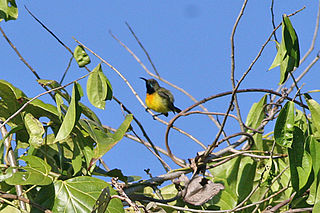
Dicaeum is a genus of birds in the flowerpecker family Dicaeidae, a group of passerines tropical southern Asia and Australasia from India east to the Philippines and south to Australia. The genus Dicaeum is closely related to the genus Prionochilus and forms a monophyletic group.

The thick-billed flowerpecker is a tiny bird in the flowerpecker group. They feed predominantly on fruits and are active birds that are mainly seen in the tops of trees in forests. It is a resident bird with a wide distribution across tropical southern Asia from India east to Indonesia and Timor with several populations recognized as subspecies some of which are sometimes treated as full species.

The olive-crowned flowerpecker is a small passerine bird in the flowerpecker family, Dicaeidae. It is found in far western New Guinea and on adjacent islands.

The grey-sided flowerpecker is a species of bird in the family Dicaeidae. It is endemic to Indonesia. Its natural habitats are subtropical or tropical moist lowland forest and subtropical or tropical moist montane forest.

The fire-breasted flowerpecker is a species of bird in the family Dicaeidae found in the Indian Subcontinent and Southeast Asia. Like other flowerpeckers, this tiny bird feeds on fruits and plays an important role in the dispersal of fruiting plants. Unlike many other species in the genus, this species has marked sexual dimorphism with the male having contrasting upper and lower parts with a distinctive bright orange breast patch. The female is dull coloured.

The black-sided flowerpecker, also known as the Bornean flowerpecker, is a species of bird in the family Dicaeidae. It is endemic to the island of Borneo, where it is found in the mountains, primarily above 1,000 m (3,300 ft) in elevation. The species is sexually dimorphic. The male has glossy blue-black upperparts, with a scarlet throat and breast, a dark grey upper belly, olive flanks, a white lower belly, and a buffy vent and undertail coverts. The female is olive-green above and greyish below, with buffy flanks and a whitish throat. It inhabits a range of forest habitats, including primary and secondary montane forest, kerangas forest, and scrub, and is also occasionally found in gardens. It feeds primarily on small fruits—particularly mistletoe berries—as well as seeds, nectar, and various invertebrates. It builds a nest of moss, camouflaged on the outside with lichens and lined with the pith of tree ferns. The International Union for Conservation of Nature rates it as a species of least concern. Though its numbers have not been quantified, the black-sided flowerpecker is said to be common throughout much of its range, and any declines are not thought to be precipitous. However, destruction of forest for palm plantations may impact it.

The Javan flowerpecker, formerly named the blood-breasted flowerpecker, is a species of passerine bird in the flowerpecker family Dicaeidae. It is found on the Indonesian islands of Java and Bali in the Lesser Sunda Islands. Its natural habitats are subtropical or tropical moist lowland forest and subtropical or tropical moist montane forest. It was formerly considered to be conspecific with the Flores, Sumba, and Timor flowerpeckers.

The ashy flowerpecker is a species of bird in the family Dicaeidae. It is endemic to Indonesia where it occurs on Seram, Ambon and nearby islands in the Banda Arc. Its natural habitats are subtropical or tropical moist lowland forest and subtropical or tropical moist montane forest.

The apricot-breasted sunbird is a species of bird in the family Nectariniidae. It is endemic to the island of Sumba in Indonesia, where its natural habitats are subtropical or tropical moist lowland forests and subtropical or tropical moist montane forests. Although it is quite common, very little is known about its biology, with virtually nothing known about its breeding or diet.

The flame-crowned flowerpecker is a species of bird in the family Dicaeidae. It is endemic to Mindanao in the Philippines. The yellow-crowned flowerpecker, which is endemic to Luzon, was formerly considered conspecific.

The Flores Sea sunbird is a species of bird in the sunbird family Nectariniidae that is found on several small islands in the Flores Sea. It was formerly considered to be a subspecies of the olive-backed sunbird, now renamed the garden sunbird.
The pink-breasted flowerpecker is a species of bird in the family Dicaeidae that is native to the south and southeast Maluku Islands of Indonesia. It was formerly considered a subspecies of the mistletoebird.
The Cambodian flowerpecker is a species of bird in the family Dicaeidae that is native to east Thailand and Cambodia. It was formerly considered to be a subspecies of the fire-breasted flowerpecker.
The Sumatran flowerpecker is a species of bird in the family Dicaeidae that is found in montane Sumatra. It was formerly considered to be a subspecies of the fire-breasted flowerpecker.

The fire-throated flowerpecker is a species of bird in the flowerpecker family Dicaeidae that is found in the Philippines except on the islands of Mindoro, the Palawan group and the Sulu Archipelago. It was formerly considered to be a subspecies of the fire-breasted flowerpecker.
The Selayar whistler is a species of bird in the family Pachycephalidae. It is endemic to the small island of Selayar, which lies to the south of Sulawesi in Indonesia. It was formerly considered to be a subspecies of the rusty-breasted whistler.
The Flores flowerpecker is a species of passerine bird in the flowerpecker family Dicaeidae that is found in mountainous regions of the Indonesian island of Flores, one of the Lesser Sunda Islands. Its natural habitats is subtropical or tropical moist montane forest. It was formerly considered to be a subspecies of the blood-breasted flowerpecker, now renamed the Javan flowerpecker.
The Timor flowerpecker is a species of passerine bird in the flowerpecker family Dicaeidae that is found on the island of Timor, one of the Lesser Sunda Islands. Its natural habitat is subtropical or tropical moist forest. It was formerly considered to be a subspecies of the blood-breasted flowerpecker, now renamed the Javan flowerpecker.













